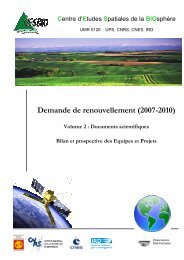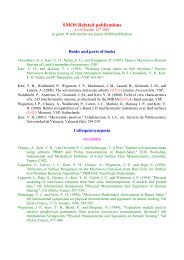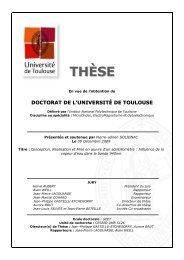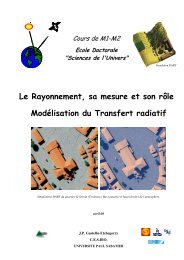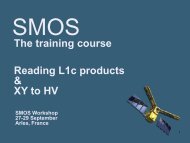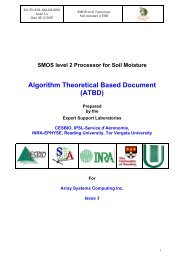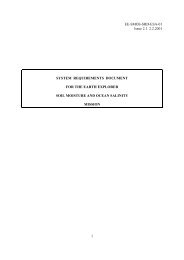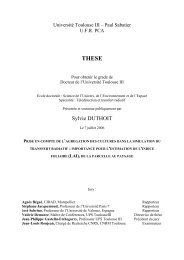thèse - CESBIO
thèse - CESBIO
thèse - CESBIO
Create successful ePaper yourself
Turn your PDF publications into a flip-book with our unique Google optimized e-Paper software.
ABSTRACTWater consumption estimates for agricultural crops in the Tensift ALHaouz region: Modelling, Experiments and Remote SensingThis study was conducted within the Framework of the Sudmed project. The latter isan applied study that deals with the characterization, modelling and forecasting of hydroecologicalresources in the semi-arid region of Tensift Al Haouz, Marrakech, Morocco. TheSudmed project is carried out jointly by a team of researchers of the Institute of Research forthe Development (IRD), and by the Faculty of Science Semlalia (Cadi Ayyad University,Marrakech).The objective of our study is to develop a methodology allowing to combine a modelof surface flux and remote sensing data in order to estimate crop water requirement in thesemi arid region of the Tensift Al Haouz. The FAO-56 model based on the concepts of cropcoefficientsK c and reference evapotranspiration ( ET0) was used. Derivation of the localizedK c for the dominant crops (wheat, olives and citrus) in the Tensift Al Haouz is advisable forproper irrigation management.The method adopted here is based on the experimental and the theoretical study onmodeling of Soil Vegetation Atmosphere Transfer. The simple and operational model namedFAO-56 (Allen et al. 1998) was used. In order to calibrate and validate this model, severalexperiments measurements was made in three fields of study: wheat, olives and citrus. Theresults showed that he FAO-56 model gave accurate estimates of crop water requirement inthis semi-arid region.Since the dual approach predicts separately soil evaporation and plant transpiration, anattempt was made to validate this partitioning of evapotranspiration with the measurements ofsap flow in the olive orchard. This partitioning allowed quantifying the lost of the water bysoil evaporation due to the flooding irrigation. A large quantity of water is lost by direct soilevaporation (30% of the irrigation), which can be saved by a judicious choice of the techniqueof irrigation (drip irrigation for example)At large scale, we combined between the ground measurements and remote sensingdata acquired by high spatial resolution (SPOT and Landsat) in order to spatial the FAO-56dual approach. Following this approach, two parameters must be estimated in order to get themaps of crop water requirements. The first parameter is the reference evapotranspiration ET0,xi





